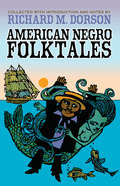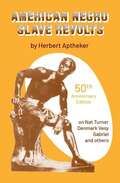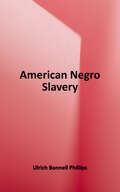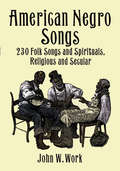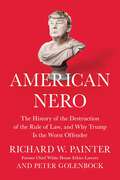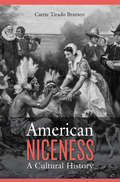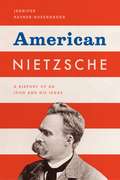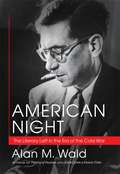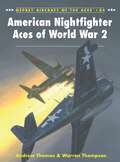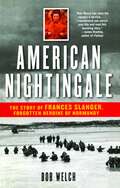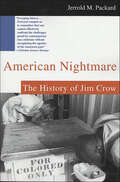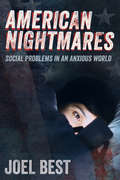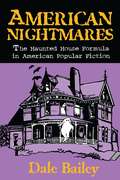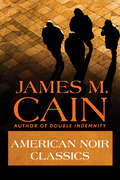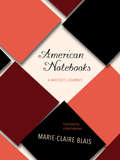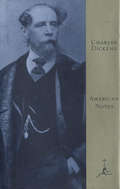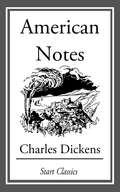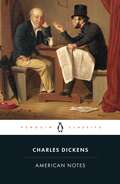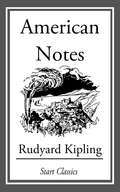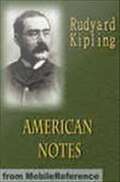- Table View
- List View
American Negro Folktales
by Richard M. DorsonA preacher battles a bear, a mother returns from the dead, and a clever servant conducts a Big Feet Contest in this rich anthology of African-American folklore. Scores of humorous and harrowing stories, collected during the mid-twentieth century, tell of talking animals, ghosts, devils, and saints.The first part of the book provides a setting for the fables, in which folklorist Richard M. Dorson discusses their origins and the artistry of storytellers. The second part consists of the tales, which include the adventures of Old Marster and John, supernatural episodes, and comical and satirical anecdotes as well as more realistic accounts of racial injustice. Recounted in the actual words of the narrators, the folktales abound in bold language, memorable imagery, and bittersweet humor that reflect the essence of African-American storytelling traditions.
American Negro Slave Revolts
by Herbert ApthekerYears ago, the controlling view held that the response of the slaves in the United States to their bondage "was one of passivity and docility". That opinion, so decisive a part of the chauvinism afflicting the nation, is shown to be false in this book and in the material accumulated since its initial appearance has further substantiated this thesis; namely, that the African-American people, in slavery, forged a record of discontent and of resistance comparable to that marking the history of any other oppressed people.
American Negro Slavery: A Survey of the Supply, Employment, and Control of Negro Labor as Determined by the Plantation Regime
by Ulrich Bonnell PhillipsOriginally published in 1918, Ulrich Bonnell Phillips?s American Negro Slavery was widely hailed upon publication as the most comprehensive and accurate examination of enslaved Africans in the South by an academic historian. In the 1950s, however, a new generation of historians?led by Kenneth Stamp?challenged many of Phillips?s inaccurate and racist views about slavery. While many historians today acknowledge that American Negro Slavery is a pioneering work, most agree that Phillips?s misunderstandings, misinterpretations, and overt racism profoundly diminish his conclusions. This 1966 edition includes a foreword by Eugene D. Genovese, author of numerous academic works on slavery, including the Bancroft Prize-winning Roll, Jordan, Roll: The World the Slaves Made (1974).
American Negro Songs: 230 Folk Songs and Spirituals, Religious and Secular
by John W. WorkFrom joyous gospel to deeply felt blues, this wonderful collection contains vintage songs sung and played through the years by black Americans — at work, in church, and for pure entertainment. Included are spirituals, blues, work songs, and a variety of social and dance songs.This important volume was originally compiled in 1940 by Dr. John W. Work, the noted musicologist affiliated with Fisk University and the celebrated Fisk Jubilee Singers. In it, he discusses the origins and history of black American folk music, the influence of slavery and African cultures, and the lyric significance of such much-loved songs as "Swing Low, Sweet Chariot," Steal Away to Jesus," "Lord, I Want to Be a Christian," and "John Henry." These informative notes lead up to the heart of the book: the complete words and music for 230 religious and secular songs, including "Study War No More," "Keep Me from Sinking Down," "You May Bury Me in the East," "Rock of Ages," "Go Tell It on the Mountain," and many others.This is an indispensable treasury of music for singers, musicians and all readers seeking a comprehensive sourcebook of black American folk music. It will be equally welcomed at parties, family get-togethers, sing-alongs, church events, and other gatherings where people want to play and sing these classic folk songs that are an integral part of American musical history.
American Nerd: The Story of My People
by Benjamin NugentMost people know a nerd when they see one but can't define just what a nerd is. American Nerd: The Story of My People gives us the history of the concept of nerdiness and of the subcultures we consider nerdy. What makes Dr. Frankenstein the archetypal nerd? Where did the modern jock come from? When and how did being a self-described nerd become trendy? As the nerd emerged, vaguely formed, in the nineteenth century, and popped up again and again in college humor journals and sketch comedy, our culture obsessed over the designation. Mixing research and reportage with autobiography, critically acclaimed writer Benjamin Nugent embarks on a fact-finding mission of the most entertaining variety. He seeks the best definition of nerd and illuminates the common ground between nerd subcultures that might seem unrelated: high-school debate team kids and ham radio enthusiasts, medieval reenactors and pro-circuit Halo players. Why do the same people who like to work with computers also enjoy playing Dungeons & Dragons? How are those activities similar? This clever, enlightening book will appeal to the nerd (and antinerd) that lives inside all of us.
American Nero: The History of the Destruction of the Rule of Law, and Why Trump Is the Worst Offender
by Peter Golenbock Richard PainterDonald Trump is eroding the rule of law! We've heard it said many times, and we can feel it in our guts. But what does "rule of law" really mean? And what happens when it breaks down? From Richard Painter, a senate candidate and law professor who served as White House chief ethics counsel under President George W. Bush, and New York Times bestselling author Peter Golenbock, American Nero is an in-depth exploration the rule of law—the legal bedrock on which this country was founded. Painter and Golenbock present a clear description of rule of law—arguably the single most important principle underlying our civilization. They also describe the abuses of power that have occurred throughout our nation's history. Beginning in Puritan New England with the infamous Salem Witch Trials, American Nero makes vivid stops at The Red Scare of the 1920s, Japanese-American internment, the McCarthy Era, and, much more recently, President Trump's attempt to violate the First Amendment by banning Muslims from entering the US. While Trump is not the first offender, he is arguably the most blatant, and this unflinchingly honest and insightful work presents in devastating detail the ways in which our current president has trampled the rule of law with his attacks on the freedom of the press, the independence of the judiciary, and the autonomy of the justice department. This is not a book about right vs. left —instead, it is about the rule of law, a principle that transcends partisan politics, and how vital it is to the survival of our country. This book serves as a call-to-action, looking ahead to a brighter future for our country, one where citizens and officials alike protect our rights and honor their responsibilities. Timely and revealing, American Nero shares the lessons of history and lays the framework for returning to a society that respects the rule of law—an America that is consistent with our Founding Fathers' vision of a genuinely free nation.
American Newsfilm 1914-1919: The Underexposed War (Routledge Library Editions: The First World War)
by David H. MouldThe First World War was the first conflict in which film became a significant instrument of propaganda. For the United States, the war had two distinct phases: from August 1914 to April 1917, America was officially a neutral country; after April 1917 the United States was in the war, providing men, money and munitions for the Allies. These two phases are mirrored in the newsreels and documentary films shown in the United States. This volume starts by examining the background to the war for the movie industry – the coverage of previous conflicts and the growth of the newsreel. It examines the experiences of American cameramen who worked in the war zone: their efforts to gain access to the front, to overcome problems ranging from unreliable equipment to poor lighting conditions to evading censorship and how this shaped the coverage of the war.
American Niceness: A Cultural History
by Carrie Tirado BramenThe cliché of the Ugly American—loud, vulgar, materialistic, chauvinistic—still expresses what people around the world dislike about their Yankee counterparts. Carrie Tirado Bramen recovers the history of a different national archetype—the nice American—which has been central to ideas of American identity since the nineteenth century.
American Nietzsche: A History of an Icon and His Ideas
by Jennifer Ratner-RosenhagenIf you were looking for a philosopher likely to appeal to Americans, Friedrich Nietzsche would be far from your first choice. After all, in his blazing career, Nietzsche took aim at nearly all the foundations of modern American life: Christian morality, the Enlightenment faith in reason, and the idea of human equality. Despite that, for more than a century Nietzsche has been a hugely popular—and surprisingly influential—figure in American thought and culture. In American Nietzsche, Jennifer Ratner-Rosenhagen delves deeply into Nietzsche's philosophy, and America’s reception of it, to tell the story of his curious appeal. Beginning her account with Ralph Waldo Emerson, whom the seventeen-year-old Nietzsche read fervently, she shows how Nietzsche’s ideas first burst on American shores at the turn of the twentieth century, and how they continued alternately to invigorate and to shock Americans for the century to come. She also delineates the broader intellectual and cultural contexts within which a wide array of commentators—academic and armchair philosophers, theologians and atheists, romantic poets and hard-nosed empiricists, and political ideologues and apostates from the Left and the Right—drew insight and inspiration from Nietzsche’s claims for the death of God, his challenge to universal truth, and his insistence on the interpretive nature of all human thought and beliefs. At the same time, she explores how his image as an iconoclastic immoralist was put to work in American popular culture, making Nietzsche an unlikely posthumous celebrity capable of inspiring both teenagers and scholars alike. A penetrating examination of a powerful but little-explored undercurrent of twentieth-century American thought and culture, American Nietzsche dramatically recasts our understanding of American intellectual life—and puts Nietzsche squarely at its heart.
American Night
by Alan M. WaldAmerican Night, the final volume of an unprecedented trilogy, brings Alan Wald's multigenerational history of Communist writers to a poignant climax. Using new research to explore the intimate lives of novelists, poets, and critics during the Cold War, Wald reveals a radical community longing for the rebirth of the social vision of the 1930s and struggling with a loss of moral certainty as the Communist worldview was being called into question. The resulting literature, Wald shows, is a haunting record of fracture and struggle linked by common structures of feeling, ones more suggestive of the "negative dialectics" of Theodor Adorno than the traditional social realism of the Left. Establishing new points of contact among Kenneth Fearing, Ann Petry, Alexander Saxton, Richard Wright, Jo Sinclair, Thomas McGrath, and Carlos Bulosan, Wald argues that these writers were in dialogue with psychoanalysis, existentialism, and postwar modernism, often generating moods of piercing emotional acuity and cosmic dissent. He also recounts the contributions of lesser known cultural workers, with a unique accent on gays and lesbians, secular Jews, and people of color. The vexing ambiguities of an era Wald labels "late antifascism" serve to frame an impressive collective biography.
American Nightfighter Aces of World War 2
by Chris Davey Warren ThompsonThe Americans lagged behind their European contemporaries in military aviation in the late 1930s, and it took the Battle of Britain to awaken an isolated America to the necessity of having aircraft that could defend targets against nighttime attack by bomber aircraft. With the help of the RAF, the importance of creating such a specialized fighter force was given top priority. This book examines the numerous aircraft types that were used by the US in this role, beginning with the early 'stop-gap' conversions like the TBM Avenger, Lockheed Ventura and the A-20 Havoc (P-70). It goes on to detail the combat history of the newer and radar equipped Hellcats, Corsairs and Black Widows that were designed to seek out enemy aircraft (both German and Japanese) in Europe, the Mediterranean and the Pacific. It was these aircraft that registered most of the kills made by the Navy, Marine Corps and USAAF in 1944-45. Finally there are additional accounts from the American pilots who spent time on the frontline on exchange tours with the RAF in the ETO/MTO, learning the intricacies of flying radar-equipped fighters like the Mosquito and Beaufighter at night, prior to the USAAF taking receipt of the much-delayed P-61. With full color profiles and rare photographs, this is an absorbing account of an often underestimated flying force: the American Nightfighters.
American Nightingale: The Story of Frances Slanger, Forgotten Heroine of Normandy
by Bob WelchOf the 350,000 American women in uniform during World War II, none instilled more hope in American GIs than Frances Slanger. In Army fatigues and helmet she splashed ashore with the first nurses to hit the Normandy beach in June 1944. Later, from a storm-whipped tent amid the thud of artillery shells, she wrote a letter to Stars and Stripes newspaper that would stir the souls of thousands of weary soldiers. Hundreds wrote heartfelt responses, praising Slanger and her fellow nurses and honoring her humility and patriotism. But Frances Slanger never got to read such praise. She was dead, killed the very next day when German troops shelled her field hospital, the first American nurse to die in Europe after the landing at Normandy. Frances Slanger was a Jewish fruit-peddler's daughter who survived a chilling childhood in World War I-torn Poland and immigrated to America at age seven. Inspired by memories of her bitter past and a Nazi-threatened future, she defied her parents' wishes by becoming a nurse and joining the military. A woman of great integrity and courage, she was also a passionate writer and keeper of chapbooks. This is the story of her too brief life.
American Nightmare: The History of Jim Crow
by Jerrold M. Packard“A very powerful and unsettling story of our nation’s century-long ‘pogrom’ by vengeful white Southerners against their black neighbors.” —The Washington TimesFor a hundred years after the end of the Civil War, a quarter of all Americans lived under a system of legalized segregation called Jim Crow. Together with its rigidly enforced canon of racial “etiquette,” these rules governed nearly every aspect of life—and outlined draconian punishments for infractions.The purpose of Jim Crow was to keep African Americans subjugated at a level as close as possible to their former slave status. Exceeding even South Africa’s notorious apartheid in the humiliation, degradation, and suffering it brought, Jim Crow left scars on the American psyche that are still felt today. American Nightmare examines and explains Jim Crow from its beginnings to its end: how it came into being, how it was lived, how it was justified, and how, at long last, it was overcome only a few short decades ago. Most importantly, this book reveals how a nation founded on principles of equality and freedom came to enact as law a pervasive system of inequality and virtual slavery.Although America has finally consigned Jim Crow to the historical graveyard, Jerrold Packard shows why it is important that this scourge—and an understanding of how it happened—remain alive in the nation’s collective memory.“Sweeping history . . . Packard compels us to remember that one cannot effectively confront the challenges posed by contemporary race relations without recognizing the agonies of the American past.” —The Christian Science Monitor
American Nightmares: Social Problems in an Anxious World
by Joel BestIn an accessible and droll style, well-known sociologist Joel Best shines a light on how we navigate these anxious, insecure social times. While most of us still strive for the American Dream—to graduate from college, own a home, work toward early retirement—recent generations have been told that the next generation will not be able to achieve these goals, that things are getting—or are on the verge of getting—worse. In American Nightmares, Best addresses the apprehension that we face every day as we are bombarded with threats that the social institutions we count on are imperiled. Our schools are failing to teach our kids. Healthcare may soon be harder to obtain. We can’t bank on our retirement plans. And our homes—still the largest chunk of most people’s net worth—may lose much of their value. Our very way of life is being threatened! Or is it? With a steady voice and keen focus, Best examines how a culture develops fears and fantasies and how these visions are created and recreated in every generation. By dismantling current ideas about the future, collective memory, and sociology’s marginalization in the public square, Best sheds light on how social problems—and our anxiety about them—are socially constructed.
American Nightmares: The Haunted House Formula in American Popular Fiction
by Dale BaileyWhen Edgar Allan Poe set down the tale of the accursed House of Usher in 1839, he also laid the foundation for a literary tradition that has assumed a lasting role in American culture. "The House of Usher" and its literary progeny have not lacked for tenants in the century and a half since: writers from Nathaniel Hawthorne to Stephen King have taken rooms in the haunted houses of American fiction. Dale Bailey traces the haunted house tale from its origins in English gothic fiction to the paperback potboilers of the present, highlighting the unique significance of the house in the domestic, economic, and social ideologies of our nation. The author concludes that the haunted house has become a powerful and profoundly subversive symbol of everything that has gone nightmarishly awry in the American Dream.
American Noir Classics
by James M. CainA collection of hardboiled crime fiction from the author of Double Indemnity, “one of the greats of American noir” (The Guardian). They call him Lucky—but he’s never had a lucky day in his life. A nineteen-year-old hobo just starting to ride the rails, he is hiding in the coal car when the railroad detective comes through. They get into a scuffle, and Lucky’s hand finds a railroad spike. . . .“Dead Man” is just one of the outstanding stories in this collection by the author renowned for insightful and exciting crime stories. Hailed as a “poet of the tabloid murder” by legendary critic Edmund Wilson and a Mystery Writers of America Grand Master, James M. Cain, understood fear in all its forms—and knew better than anyone the terror of a killer on the run. This volume includes:“The Baby in the Icebox” • “Pay-Off Girl” • “Two o’Clock Blonde” • “The Birthday Party” * “Brush Fire” • “Coal Black” • “Career in C Major” • “Death on the Beach” • “Dead Man” • “The Girl in the Storm” • “Joy Ride to Glory” • “Pastorale” • “Mommy’s a Barfly” • “The Taking of Montfaucon” • “Cigarette Girl” • “The Robbery” • “Blackmail”
American Nonpublic Schools: Patterns of Diversity
by Otto F. KraushaarThis book is about the nonpublic or private schools of America--their history, goals, significance, problems, and prospects. It was undertaken in the belief that these schools, which at their crest educated approximately 6.5 million children in about 19 thousand elementary and secondary schools, constitute an important resource in America's dual system of public and private schooling, a resource which is currently in serious jeopardy.
American Notebook: A Personal and Political Journey
by Michael GawendaOne of the rewards extended to former editors—if they are lucky and get to plan their departure—is that they can choose their next assignment. I had no doubt about what I wanted: to be Washington correspondent for The Age and The Sydney Morning Herald. There was no more important and interesting international story to cover than the United States at the beginning of George W. Bush's second term. The war in Iraq was going badly, and it was not at all clear that the war on terror was being won—or even if there was any agreement that it was, in fact, a war. When veteran journalist Michael Gawenda was posted to the USA as a Washington correspondent in 2005, George W. Bush was beginning his second term, and the war in Iraq was showing signs of becoming a quagmire. Two years later, Bush is a lame duck president and most Americans want their troops out of Iraq. American Notebook is Gawenda's absorbing and insightful account of his American posting. Weaving the personal into the political, Gawenda takes the reader on his journey into a country he has always loved. Beyond daily life in Washington, he visits hurricane-ravaged New Orleans and the God-fearing states of the Midwest. His engaging analysis of politics and current events is interwoven with his reflections on his childhood as a post-war Jewish refugee, growing up in the sixties in a Melbourne steeped in American culture. In light of the increasingly evident failure of efforts in Iraq, he revisits his own controversial decision while editor of The Age newspaper to support the Howard Government's decision in 2003 to join the coalition of the willing. American Notebook is a fascinating discussion of the role of journalism and the nature of public debate about war, politics and current events.
American Notebooks: A Writer's Journey
by Marie-Claire BlaisIt is the spring of 1963. The young Quebec author Marie-Claire Blais, bursting with energy and talent, has just won a coveted Guggenheim fellowship. She chooses Cambridge, Massachusetts, as the place where she will begin her writer's apprenticeship with her mentor, Edmund Wilson. American Notebooks is much more than a fascinating autobiographical account of the intellectual flowering of a great writer. An album of exquisitely drawn literary portraits of companions, intellectuals, writers, musicians, artists and social activists of the period--Edmund and Elena Wilson; Mary Meigs; Maud Maugan; Barbara Deming; Truman Capote; Jacques Hébert, her first Quebec publisher, then senator; and many others--it also introduces many of the real life personalities who have inspired her fictional characters.
American Notes
by Charles DickensWhen Charles Dickens set out for America in 1842 he was the most famous man of his day to travel there - curious about the revolutionary new civilization that had captured the English imagination. His frank and often humorous descriptions cover everything from his comically wretched sea voyage to his sheer astonishment at the magnificence of the Niagara Falls, while he also visited hospitals, prisons and law courts and found them exemplary. But Dickens's opinion of America as a land ruled by money, partly built on slavery, with a corrupt press and unsavoury manners, provoked a hostile reaction on both sides of the Atlantic. American Notes is an illuminating account of a great writer's revelatory encounter with the New World.
American Notes
by Charles DickensCharles Dickens was the most famous of many travelers of his time who journeyed to America, curious about the revolutionary new civilization that had captured the English imagination. His frank, often humorous descriptions in his 1842 account cover everything from his uncomfortable sea voyage to an ecstatic narrative of his visit to Niagara Falls. Yet Dickens is also critical of American society, its preoccupation with money, and reliance on slavery, as well as the rude, unsavory manners of Americans and their corrupt press. Above all, American Notes is a lively chronicle of what was for Dickens an illuminating encounter with the New World.
American Notes
by Charles DickensTrajectory presents classics of world literature with 21st century features! Our original-text editions include the following visual enhancements to foster a deeper understanding of the work: Word Clouds at the start of each chapter highlight important words. Word, sentence, paragraph counts, and reading time help readers and teachers determine chapter complexity. <P> <P> Co-occurrence graphs depict character-to-character interactions as well character to place interactions. Sentiment indexes identify positive and negative trends in mood within each chapter. Frequency graphs help display the impact this book has had on popular culture since its original date of publication. Use Trajectory analytics to deepen comprehension, to provide a focus for discussions and writing assignments, and to engage new readers with some of the greatest stories ever told. "American Notes" by Charles Dickens is an account of Dickens' five month trip across America and Canada in 1842. Read this story to get a humorous and honest portrayal of life in America in the 19th century!
American Notes
by Charles Dickens'Like Shakespeare, Dickens was able to embrace a whole world' John MortimerWhen Charles Dickens set out for America in 1842, he was the most famous man of his day to make the journey, and embarked on his travels with an intense curiosity. His frank descriptions cover everything from his comically wretched sea voyage to his sheer astonishment at Niagara Falls, while he also visited hospitals, prisons and law courts. But Dickens's depiction of America as a land ruled by money, built on slavery, with a corrupt press and unsavoury manners, provoked a hostile reaction on both sides of the Atlantic. American Notes is an illuminating account of a great writer's revelatory encounter with the New World.Edited with an Introduction and Notes by Patricia Ingham
American Notes
by Rudyard KiplingIt is hardly fair to Mr. Kipling to call American Notes first impressions, for one reading them will readily see that the impressions are superficial, little thought being put upon the writing. They seem super-sarcastic, and would lead one to believe that Mr. Kipling is antagonistic to America in every respect. This, however, is not true. These Notes aroused much protest and severe criticism when they appeared in 1891, and are considered so far beneath Mr. Kipling's real work that they have been nearly suppressed and are rarely found in a list of his writings.
American Notes
by Rudyard KiplingThis is what Bret Harte has written of the great city of San Francisco, and for the past fortnight I have been wondering what made him do it. There is neither serenity nor indifference to be found in these parts; and evil would it be for the continents whose wardship were intrusted to so reckless a guardian. Behold me pitched neck-and-crop from twenty days of the high seas into the whirl of California, deprived of any guidance, and left to draw my own conclusions. <P> <P> Protect me from the wrath of an outraged community if these letters be ever read by American eyes San Francisco is a mad city--inhabited for the most part by perfectly insane people, whose women are of a remarkable beauty. .
